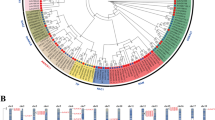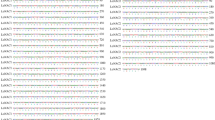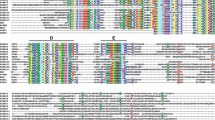Abstract
In this study, four nuclear transcription factor Y subunit alpha (NFYA) homologous genes, LaNFYA1, LaNFYA2, LaNFYA3, and LaNFYA4, were isolated from Japanese larch (Larix leptolepis). The deduced amino acid sequences of the LaNFYAs harbored a highly conserved core region consisting of two functional domains: a subunit association domain and a DNA-binding homeodomain. Further analysis showed that miR169 target sequences were present in the 3′ end of all four LaNFYA mRNA sequences. A transient expression analysis of the LaNFYA-GFP fusion proteins in tobacco leaf epidermal cells revealed that the LaNFYA proteins were localized in the nucleus. An analysis of tissue expression levels of the LaNFYAs showed that expression was highest in the stems and lowest in the needles, demonstrating a pattern of temporal- and spatial-specific expression. Their mRNA accumulation patterns during somatic embryogenesis, and the effects of abscisic acid (ABA) on their transcript levels and somatic embryo maturation were investigated. The results showed that the transcripts of the four genes gradually increased and peaked at 7 days, followed by a decline as the somatic embryos matured, and that the removal of the ABA treatment did not affect the mRNA abundance of LaNFYA1, LaNFYA2, and LaNFYA3 during the first 14 days, but up-regulated the abundance of LaNFYA4 mRNA. We concluded that LaNFYAs may be involved with the early determination and maturation of the somatic embryo, which is regulated by responses to ABA and miR169. These results provide new insights into the regulatory mechanisms of somatic embryogenesis.






Similar content being viewed by others
References
Arc E, Sechet J, Corbineau F, Rajjou L, Marion-Poll A (2013) ABA crosstalk with ethylene and nitric oxide in seed dormancy and germination. Front Plant Sci 4:63
Bohlenius H, Huang T, Charbonnel-Campaa L, Brunner AM, Jansson S, Strauss SH, Nilsson O (2006) CO/FT regulatory module controls timing of flowering and seasonal growth cessation in trees. Science 312(5776):1040–1043
Bozhkov PV, Filonova LH, von Arnold S (2002) A key developmental switch during Norway spruce somatic embryogenesis is induced by withdrawal of growth regulators and is associated with cell death and extracellular acidification. Biotechnol Bioeng 77(6):658–667
Bungartz G, Land H, Scadden DT, Emerson SG (2012) NF-Y is necessary for hematopoietic stem cell proliferation and survival. Blood 119(6):1380–1389
Combier J-P, Frugier F, de Billy F, Boualem A, El-Yahyaoui F, Moreau S, Vernié T, Ott T, Gamas P, Crespi M (2006) MtHAP2-1 is a key transcriptional regulator of symbiotic nodule development regulated by microRNA169 in Medicago truncatula. Genes Dev 20(22):3084–3088
Dai X, Zhao PX (2011) psRNATarget: a plant small RNA target analysis server. Nucleic Acids Res 39(suppl 2):W155–W159
Edwards D, Murray JA, Smith AG (1998) Multiple genes encoding the conserved CCAAT-box transcription factor complex are expressed in Arabidopsis. Plant Physiol 117(3):1015–1022
Filonova LH, Bozhkov PV, Brukhin VB, Daniel G, Zhivotovsky B, von Arnold S (2000) Two waves of programmed cell death occur during formation and development of somatic embryos in the gymnosperm, Norway spruce. J Cell Sci 113:4399–4411
Finkelstein RR, Gampala SS, Rock CD (2002) Abscisic acid signaling in seeds and seedlings. Plant Cell 14(Suppl):S15–S45
Fischerova L, Fischer L, Vondrakova Z, Vagner M (2008) Expression of the gene encoding transcription factor PaVP1 differs in Picea abies embryogenic lines depending on their ability to develop somatic embryos. Plant Cell Rep 27(3):435–441
Frey A, Godin B, Bonnet M, Sotta B, Marion-Poll A (2004) Maternal synthesis of abscisic acid controls seed development and yield in Nicotiana plumbaginifolia. Planta 218(6):958–964
Gusmaroli G, Tonelli C, Mantovani R (2001) Regulation of the CCAAT-binding NF-Y subunits in Arabidopsis thaliana. Gene 264(2):173–185
Gusmaroli G, Tonelli C, Mantovani R (2002) Regulation of novel members of the Arabidopsis thaliana CCAAT-binding nuclear factor Y subunits. Gene 283(1):41–48
Gutmann M, von Aderkas P, Label P, Lelu M-A (1996) Effects of abscisic acid on somatic embryo maturation of hybrid larch. J Exp Bot 47(12):1905–1917
Kanno Y, Jikumaru Y, Hanada A, Nambara E, Abrams SR, Kamiya Y, Seo M (2010) Comprehensive hormone profiling in developing Arabidopsis seeds: examination of the site of ABA biosynthesis, ABA transport and hormone interactions. Plant Cell Physiol 51(12):1988–2001
Karssen CM, van der Swan BDL, Breekland AE, Koornneef M (1983) Induction of dormancy during seed development by endogenous abscisic acid: studies on abscisic acid deficient genotypes of Arabidopsis thaliana (L.) Heynh. Planta 157(2):158–165
Kumar V, Parvatam G, Ravishankar GA (2009) AgNO3—a potential regulator of ethylene activity and plant growth modulator. Electron J Biotechnol 12(2):8–9
Li XY, Mantovani R, van Huijsduijnen RH, Andre I, Benoist C, Mathis D (1992) Evolutionary variation of the CCAAT-binding transcription factor NF-Y. Nucleic Acids Res 20(5):1087–1091
Li W-X, Oono Y, Zhu J, He X-J, Wu J-M, Iida K, Lu X-Y, Cui X, Jin H, Zhu J-K (2008) The Arabidopsis NFYA5 transcription factor is regulated transcriptionally and posttranscriptionally to promote drought resistance. Plant Cell 20(8):2238–2251
Li Y, Fu Y, Ji L, Wu C, Zheng C (2010) Characterization and expression analysis of the Arabidopsis mir169 family. Plant Sci 178(3):271–280
Li SG, Li WF, Han SY, Yang WH, Qi LW (2013a) Stage-specific regulation of four HD-ZIP III transcription factors during polar pattern formation in Larix leptolepis somatic embryos. Gene 522(2):177–183
Li W-F, Zhang S-G, Han S-Y, Wu T, Zhang J-H, Qi L-W (2013b) Regulation of LaMYB33 by miR159 during maintenance of embryogenic potential and somatic embryo maturation in Larix kaempferi (Lamb.) Carr. Plant Cell, Tissue Organ Cult 113(1):131–136
Mu J, Tan H, Hong S, Liang Y, Zuo J (2013) Arabidopsis transcription factor genes NF-YA1, 5, 6, and 9 play redundant roles in male gametogenesis, embryogenesis, and seed development. Mol Plant 6(1):188–201
Ni Z, Hu Z, Jiang Q, Zhang H (2013) GmNFYA3, a target gene of miR169, is a positive regulator of plant tolerance to drought stress. Plant Mol Biol 82(1–2):113–129
Olesen JT, Fikes JD, Guarente L (1991) The Schizosaccharomyces pombe homolog of Saccharomyces cerevisiae HAP2 reveals selective and stringent conservation of the small essential core protein domain. Mol Cell Biol 11(2):611–619
Reyes JL, Chua NH (2007) ABA induction of miR159 controls transcript levels of two MYB factors during Arabidopsis seed germination. Plant J 49(4):592–606
Siefers N, Dang KK, Kumimoto RW, Bynum WE, Tayrose G, Holt BF (2009) Tissue-specific expression patterns of Arabidopsis NF-Y transcription factors suggest potential for extensive combinatorial complexity. Plant Physiol 149(2):625–641
Tautorus T, Fowke L, Dunstan D (1991) Somatic embryogenesis in conifers. Can J Bot 69(9):1873–1899
Von Arnold S, Hakman I (1988) Regulation of somatic embryo development in Picea abies by abscisic acid (ABA). J Plant Physiol 132(2):164–169
Wang Z, Ye S, Li J, Zheng B, Bao M, Ning G (2011) Fusion primer and nested integrated PCR (FPNI-PCR): a new high-efficiency strategy for rapid chromosome walking or flanking sequence cloning. BMC Biotechnol 11:109
Yang X, Li X, Li B, Zhang D (2013) Identification of genes differentially expressed in shoot apical meristems and in mature xylem of Populus tomentosa. Plant Mol Biol Rep. doi:10.1007/s11105-013-0660-6
Zhang S, Zhou J, Han S, Yang W, Li W, Wei H, Li X, Qi L (2010) Four abiotic stress-induced miRNA families differentially regulated in the embryogenic and non-embryogenic callus tissues of Larix leptolepis. Biochem Biophys Res Commun 398(3):355–360
Zhang J, Zhang S, Han S, Wu T, Li X, Li W, Qi L (2012a) Genome-wide identification of microRNAs in larch and stage-specific modulation of 11 conserved microRNAs and their targets during somatic embryogenesis. Planta 236(2):647–657
Zhang Y, Zhang S, Han S, Li X, Qi L (2012b) Transcriptome profiling and in silico analysis of somatic embryos in Japanese larch (Larix leptolepis). Plant Cell Rep 31(9):1637–1657
Zhang J, Zhang S, Han S, Li X, Tong Z, Qi L (2013a) Deciphering small noncoding RNAs during the transition from dormant embryo to germinated embryo in larches (Larix leptolepis). PLoS ONE 8(12):e81452
Zhang LF, Li WF, Han SY, Yang WH, Qi LW (2013b) cDNA cloning, genomic organization and expression analysis during somatic embryogenesis of the translationally controlled tumor protein (TCTP) gene from Japanese larch (Larix leptolepis). Gene 529(1):150–158
Zhao B, Ge L, Liang R, Li W, Ruan K, Lin H, Jin Y (2009) Members of miR-169 family are induced by high salinity and transiently inhibit the NF-YA transcription factor. BMC Mol Biol 10(1):29
Zhao M, Ding H, Zhu JK, Zhang F, Li WX (2011) Involvement of miR169 in the nitrogen-starvation responses in Arabidopsis. New Phytol 190(4):906–915
Acknowledgments
This work was supported by the National Natural Science Foundation of China (31330017) and the National High Technology Research and Development Program of China (2013AA102704, 2011AA100203).
Author information
Authors and Affiliations
Corresponding author
Electronic supplementary material
Below is the link to the electronic supplementary material.
Rights and permissions
About this article
Cite this article
Zhang, Lf., Li, Wf., Xu, Hy. et al. Cloning and characterization of four differentially expressed cDNAs encoding NFYA homologs involved in responses to ABA during somatic embryogenesis in Japanese larch (Larix leptolepis). Plant Cell Tiss Organ Cult 117, 293–304 (2014). https://doi.org/10.1007/s11240-014-0440-5
Received:
Accepted:
Published:
Issue Date:
DOI: https://doi.org/10.1007/s11240-014-0440-5




